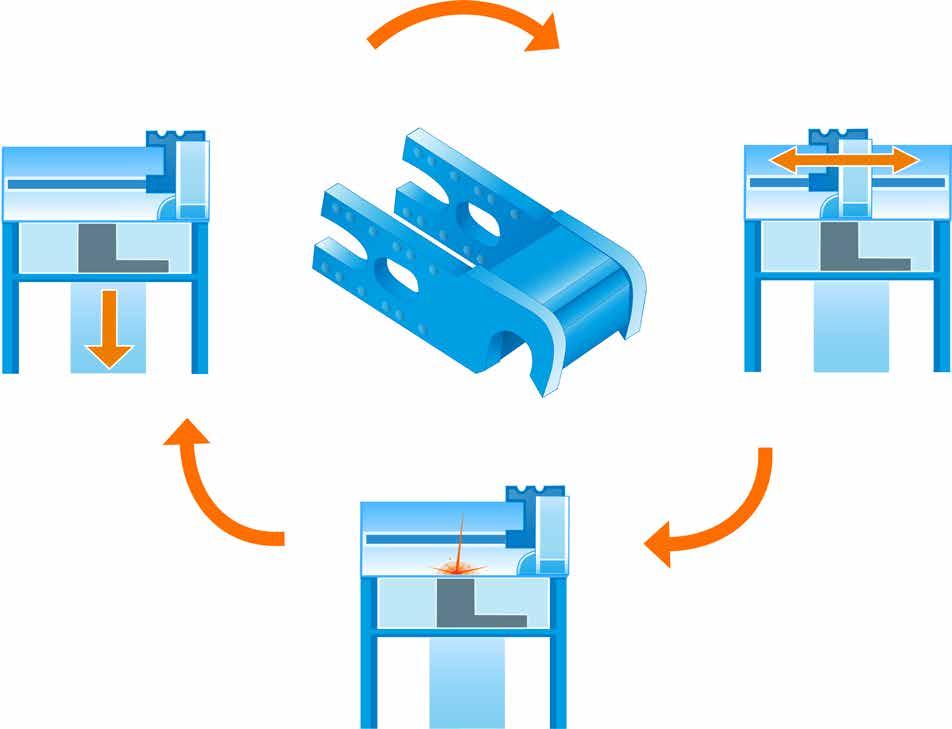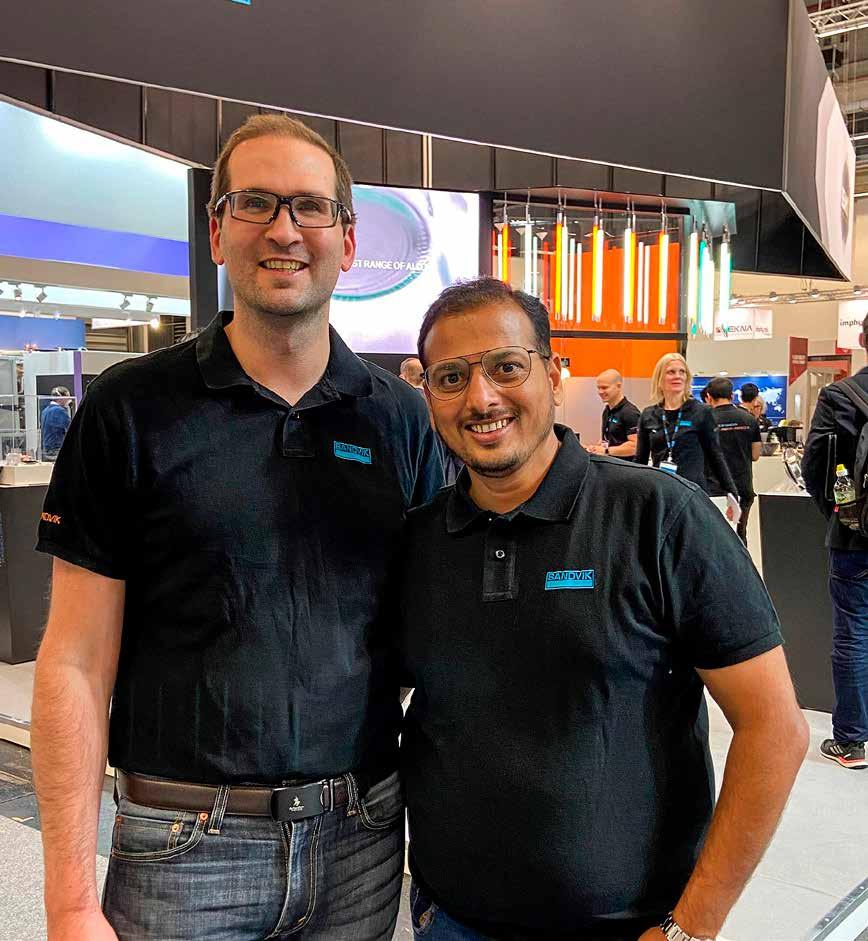
6 minute read
ADDITIVE MANUFACTURING PROCESS
The catalogue boiled down to 140 shortlisted parts with the greatest potential for AM, which were then screened even more closely to around 40 viable business cases. Sandvik’s Bangalore Design Centre in India redesigned the parts for AM together with BEAMIT Group, and production has taken place at BEAMIT’s European facilities.
The results were impressive: the average weight reduction was 25 percent, yielding a similar cost reduction because logistics costs are directly proportional to the weight. Another win was in sustainability. With an average shipping distance of 11,000 kilometres, bringing parts production closer to the end users makes business sense and yields environmental benefits. Factoring in the carbon emissions data per air mile and average annual sales, the achievable emissions reductions average roughly 50 percent, ranging between 17 percent and 75 percent. Yet another major benefit is a significant reduction in lead time, on average 37 days. This means parts can be delivered around 50 to 70 percent faster, and also increases component efficiency, which leads to energy consumption reduction and performance enhancement.
Once a single layer is complete, the base plate is lowered just enough to make room for the next layer. More material is raised from the cartridge and recoated evenly on the previously sintered layer. The equipment continues to sinter layer upon layer until the part is printed.
on a case-by-case basis, there is clearly an incentive for leaner logistics. Moreover, AM creates possibilities to ensure availability by reducing the risk of any existing parts supplier going out of business or losing interest in a low-volume part. End-of-life-cycle components and slow-moving items are less price-sensitive, so the cost premium linked with AM is less of an issue. The project also aimed to reduce spare parts inventories and net working capital by cutting back on unnecessary stock and avoiding minimum order quantities. Having AM closer to end users also helps to shorten supply chains, reduce lead times and trim logistical costs, including warehousing and customs fees.
Bhalgat’s team screened and analyzed roughly 15,000 proprietary SMR parts with an annual volume of less than 10 for their AM potential.
A great example was a fuel tank cap where brass was replaced with aluminium, yielding a total weight logy and likely to expand significantly within the next 10 or 15 years. Where does Sandvik see itself in all this?
3 Key Processes For Metal
reduction of 78 percent. The added benefits included branding with the Sandvik logo and having the part number printed on the cap.
Some challenges still remain to be tackled. A hydraulic manifold was light-weighted by 82 percent, from 36.55 kilograms to 6.65 kilograms. But despite the impressive results, successful field tests and positive feedback, the added cost was not viable.
What comes next? “The AM screening project is now advancing to its second phase,” Bhalgat says. “We will fine-tune the criteria and ignore parts approaching the end of their life cycle. This will leave us with some 5,500 parts with the most potential for a reanalysis.”
AM is a rapidly evolving techno -
Once the 3D data of the part is transferred to the AM equipment, a recoder assembly pushes powdered metal material from the powder supply to create a uniform layer over the baseplate.
A laser then draws a 2D cross section on the surface of the build material, heating and fusing the material until that layer is complete.
“AM technology is evolving very rapidly and still has to develop a lot in order produce larger, faster and more consistent parts at an economical price,” Bhalgat says. “As an end user, the biggest challenge is to have a viable business case. The industry, including equipment and powder manufacturers, universities and other research institutions are working on the current limitations, and the technology is expected to mature in the next decade. By then, we will be ready to use it at full strength. Ultimately the aim is to convert around 5 percent of our inventory, some 3,000 individual parts, into additive manufacturing by 2030.”
Sandvik and Boliden partner to trial additive manufacturing
Swedish mining and metals company Boliden has partnered with Sandvik Mining and Rock Solutions to run a trial with machine parts printed digitally and installed on underground drill rigs. The trial with Sandvik involves a set of specially redesigned components additively manufactured at a Sandvik-managed facility in Italy, with their performance being monitored on machines in Boliden’s underground mine worksites — first at the company’s Garpenberg mine in Sweden and then at a site in Ireland. One of the many benefits of digitally printed parts locally is that parts get to customers much faster and far more sustainably. Maintenance and repair operating items (such as the bushes, brackets and drill parts that customers need to change every 3,000-4,000 hours) will be the first items digitally printed.

Max Planck once said that “science advances one funeral at a time”. His point was that for any progress to be made in scientific endeavours, old thinking must be put to rest. Such is the case with electrification. Dr Nesimi Ertugrul, an associate professor at the University of Adelaide’s School of Electrical and Electronic Engineering, shares his thoughts on why the time is ripe for the change to electric at mine sites.

Q: . CAN YOU EXPLAIN WHAT YOU MEAN WHEN YOU SPEAK OF A SYNERGY BETWEEN GRID TRANSFORMATION IN DOMESTIC POWER NETWORKS AND MINING POWER NETWORKS ?
A: That synergy is based on the development of autonomous microgrids with distributed energy resources, primarily using renewable energy. Most mine sites are in remote areas and only few of them are connected to the domestic power network, but even then, usually via long transmission lines. Therefore, it is logical to develop standalone microgrids with renewable energy (solar and wind, and possibly with hydrogen in the near future), which can eliminate the limitations of the centralized network approach. Since microgrid structures are already shaping grid transformation, they can form the power grid in mine sites without significant modification.
Furthermore, electricity infrastructures and operational and maintenance costs of mine sites heavily involve diesel engines and generators, which have an impact on the cost of energy. Mine microgrids can respond to such limitations while supporting a 100 percent renewable powered transformation. Electricity transformation of the grid by the integration of renewable energy sources, along with maturity in battery storage solutions and electric vehicle technologies, have accelerated mine electrification. While several commercial electric machineries and battery vehicles are already available for mines, some hydrogen- powered vehicle trials are also underway for large-haul trucks on mining sites.
Q: WHY DO YOU THINK THAT NOW IS THE PERFECT TIME FOR ELECTRIFICATION, PARTICULARLY AT MINE SITES?
A: It’s probably about the advances in power electronics, which is the enabling technology in renewable energy and electric transportation systems. In all applications involving power electronics, similar circuit topologies use semiconductors to convert electric power to perform specific tasks. For example, in a microgrid application, a bidirectional converter can charge a battery or feed an electric load, and an identical converter can also charge the battery in an electric vehicle when it is stationary or drive an electric motor (or control it as a generator during braking) when it is mobile. In addition, the advances in semiconductor switches (specifically development in wide bandgap devices) enabled the development of high-power density (volumetric and gravimetric) converters at low cost. Therefore, the mature products of power electronics naturally became available in mining equipment.
Q WHAT BENEFITS ARE AVAILABLE TO MINERS CONCERNED ABOUT THE COST OF ELECTRI FYING THEIR EQUIPMENT?
A: We can’t underestimate the reduction of carbon emissions as a driver for change from combustion engines in mining equipment.
However, I believe that the major benefit for conversion to electric in mining is about the improvements and opportunities in system efficiency and ease of control. Diesel engines have an efficiency not more than 35 percent at rated load (at rated speed and torque) and much lower at light loads. It should be emphasized here that at low efficiency, significant heat and high emissions (diesel particulate matter) are produced as well. However, electric motor and drive efficiency can be more than 80 percent in a wide range of loads. In addition, in the mining industry, uptime needs to be maximized. Electric motor drives have several other benefits to miners, including low noise and vibrations, increased reliability, fewer mechanical components and reduced maintenance and service cost. Furthermore, the electrical systems make the monitoring of mine activities for process control and fault detection seamless and easy, which is critical for future mine sites.
Q: HOW DIFFICULT IS THE RESKILLING OF STAFF AFTER MINE ELECTRIFICATION HAS COMMENCED ?
A: It is both difficult and easy, but most of all necessary. Not all mine workers need to have a similar level of knowledge on electrification. At the highest levels, mine owners must be convinced of the value of electrification, so they need to have the knowledge of how the overall integration works. Ground-level engineers, however, must be trained on a number of fronts, including power electronics, motor drives and microgrid system components and control. At the University of Adelaide, we are already training students to be ready for these new electric realities. Therefore, we have instituted a variety of programmes to help the future workforce in the field. As a part of these, we have developed courses covering all modern distributed energy technologies. We have also created the Australian Energy Storage Knowledge Bank, where we share modern microgrid platforms with utility-scale battery storage. In addition, we are leading the mine electrification programme of the Future Battery Industries Cooperative Research Centre in Australia, which also aims to train the mining community at large.









